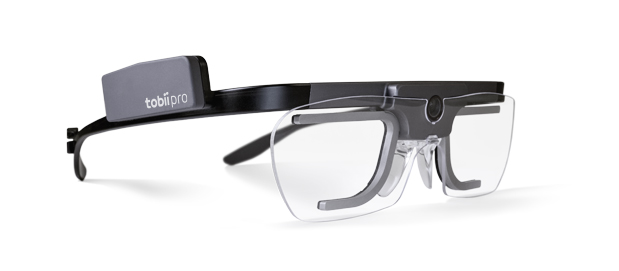The next session was on hardware and the first speaker was Matthew Clyne, from Tobii Technology, where he is a technology evangelist, working on developing partnerships and supporting developers.
Tobii was founded in 2001 and claims to be the largest eye tracking hardware supplier in the world.
There are a number of ways to do eye tracking, but Tobii uses near-infrared projectors to illuminate the user’s eye to see where their attention is focused.
 Tobii has now designed a new pair of glasses that include the projector and an HD camera to allow self contained glasses to be used (see the video at the end of this article).
Tobii has now designed a new pair of glasses that include the projector and an HD camera to allow self contained glasses to be used (see the video at the end of this article).
The first reason for eye recognition on HMDs, is that there is rarely a pointing device, which is nearly always needed in apps. You can put a reticule on glasses and see where they point, but this causes the user to change their behaviour to be “strange” by turning their head and that is not natural.
You can use gaze data to understand what the user is looking at so you could, for example, render an image depending on what the user is looking at. (There is a lot of work going on in this area, in holographic displays, for example, as they take huge amounts of computation, so only dealing with the area of interest allows a concentration of power – Man. Ed.)
XY co-ordinates with time are the core data that Tobii provides but depth can also be useful. Heat maps and linear gaze maps are easier to understand for most programmers. For applications with glasses, Tobii tends to work with software developers. Data can be used for collecting useful information such as whether the user is even present, which can be used to save power on HMDs.
Analyst Comment
I have been banging on about the importance of gaze tracking for a long time. However, there is a bit of a “chicken and egg” problem in the PC world, but it could be that the interest by Qualcomm in gaze could help to drive serious volume to bring costs down.

